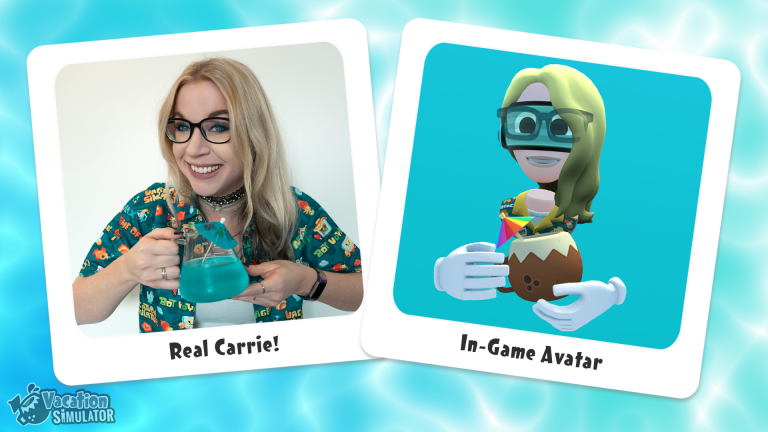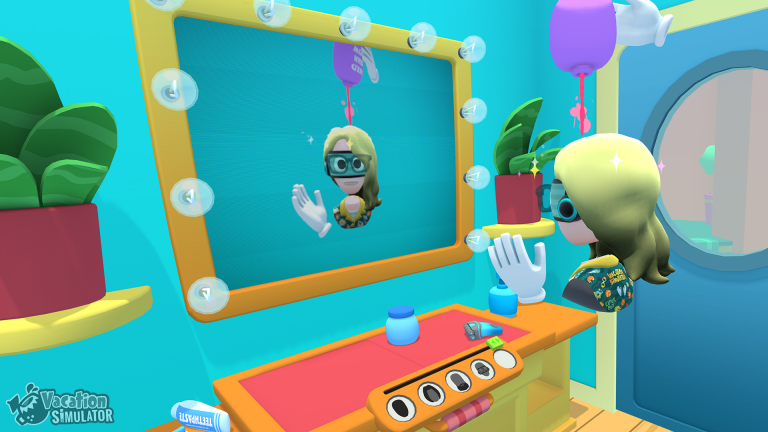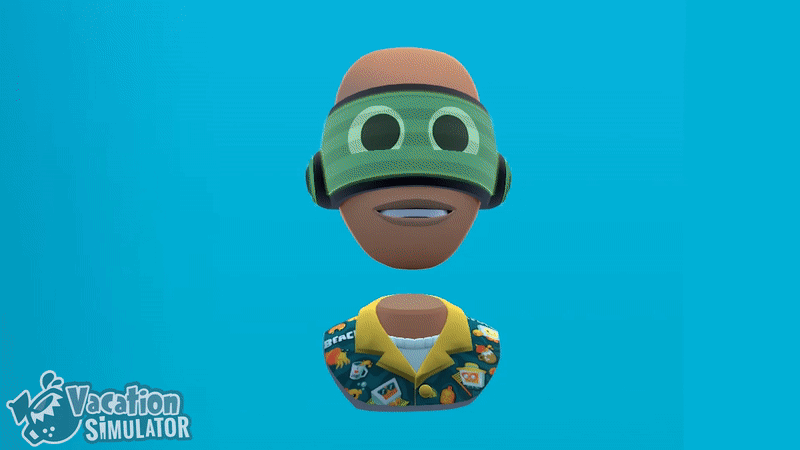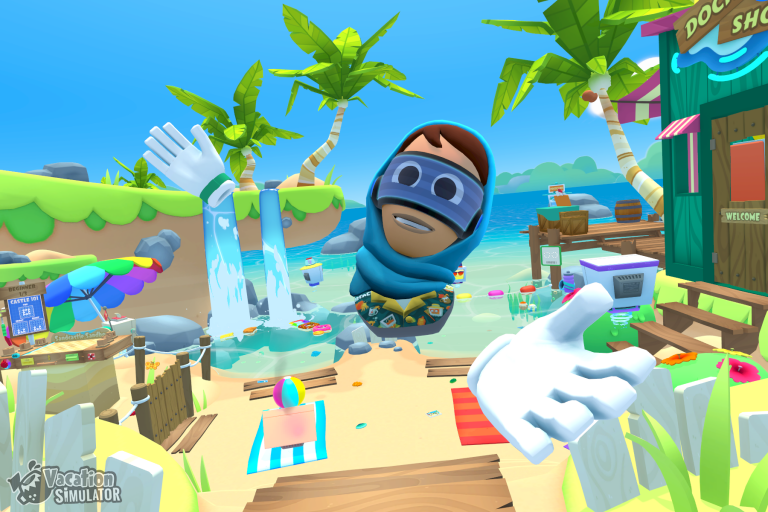Express Who You Are, in VR! Vacation Simulator’s Avatar Customizer
Hello Humans!
We’ve been hard at work at Owlchemy, continuing to add absurd amounts of interactions, an abundance of humor, and oodles of personality to the vibrant world of Vacation Simulator.
In response to the growing anticipation we’ve seen for Vacation Simulator, we’re excited to share details about a system that lets players bring themselves into the virtual world: our Avatar Customizer!
At Owlchemy Labs, “VR for everyone” is at the heart of everything we do. We believe everyone should be able to play our games, have fun, and truly feel like themselves.
To live up to this philosophy, we set out to build an avatar system that allows everyone to be represented, lets players spend as much or as little time as they want customizing, and feels both believable and relatable.
Tons of research, consultation and constant testing, testing, testing led us to the refined yet powerful set of options in the Avatar Customizer. We’re thrilled to share the results of our (ongoing) work, as well as a little bit of the process behind creating a system to represent everyone in VR.
What’s In An Avatar Customizer?
When we started development, we realized that vacations are filled with activities that require you to see yourself—dressing up for your destination, checking out new outfits in the mirror, and of course… taking selfies! For players to truly bring themselves into VR, we knew it was essential to build an avatar system beyond a floating headset and hands.
While an avatar system is a massive undertaking for any project, the nuances of developing for VR added a few layers of complexity to the task. Technical hurdles aside, the physical presence and agency of VR makes it all the more important for players to identify with their avatars. True to Owlchemy fashion, we accepted this important task gleefully!
First, to account for the vast range of visual elements that make up a person’s physical identity, we narrowed things down to what we found essential. We want our players to be able to capture the core elements of their physical appearance in order to seamlessly embody their virtual selves in their adventures across Vacation Island.
At the start of the game, you’re greeted by a friendly and accessible interface for customization— a vanity set full of switches, dials, and knobs for tweaking your avatar’s appearance. Adjust the height of the vanity with the handle, and you’re off creating your virtual self!
Our Avatar Customizer allows players to customize the following:
Skin Tone: Skin tone is the most immediate personal identifier, and one that nearly everyone considers core to their identity.
Visor Color: Instead of eye color, we let players customize the color of their visor. (You are in a VR simulation, after all…) The visor color can represent your eye color if you so choose, or be an aesthetic choice if you want it to represent your style.
Hair Style + Color: We wanted to ensure everyone could find a hair (and beard!) option that reflected their identity—be that color, texture, style, or even religious/cultural identifiers like hijabs or dastars (an important, core part of identity for many!)
Glasses: Much like with hairstyles, we know that for some people, glasses are more than an accessory—they’re a part of who you are!
Using just a few core features, we’ve polished our Avatar Customizer to be a powerful tool to create a truly believable avatar in VR. We found simplicity overall to be the key to creating an iconic representation of yourself, with optional depth in only the most essential areas.
Whether you’re taking a selfie on the beach…
…or trying to pick your favorite accessory in the Dock Shop—
We want you to feel like… well, you!
The Process + Considerations
For “everyone to feel like themselves” in our game, we had to really mean everyone. We feel a great sense of responsibility to pave the way for a more diverse, inclusive baseline for implementing avatar systems in VR. Avatar systems in games have often failed specific minority groups in the past, and alienating someone in VR with a half-baked system carries even greater consequences than in traditional games.
Everyone deserves to see and be themselves in the world—including virtual ones. Because of this, we committed ourselves to the entire scope of an avatar system. We knew that we had a lot of work ahead of us, but not how much until we started to dig deeper.
Our first step was gathering as much information as we could on our own. We took skin tone inspiration from artist Angélica Dass’ Humanae Project and Fenty’s foundation line.
With hair, we started at the texture level, learning about the 1-4C classifications for hair textures from a variety of hair and beauty websites (1: straight, 2: wavy, 3: curly, and 4: coily or kinky). Then came styling. For this, we looked at the most common haircuts across age, gender, texture, and major cultural groups and tried to represent 2-4 styles from each group.
Just this research gave us plenty to start working on, but we knew that we needed additional expertise to provide context to our existing knowledge and fill in the inevitable gaps. We reached out to fantastic groups like Google’s Product Inclusion team, our local experts from Pretty Brown & Nerdy, and even a few of our industry friends (thanks, Rami!)—all of whom helped us immensely to spot major gaps in our representation and understanding. Utilizing external help, we addressed things like a lack of hairstyles for older women and long-haired men, appropriate terms for Muslim headwear, and inaccuracies in our textures and models for curly and coily hairstyles.
Sometimes, representation even meant developing new tech. When tackling black male hairstyles, we implemented a method for transparency gradients in hair to capture the look of the fade. We also wanted longer hairstyles to move with the player, so we developed custom physics tech for long hair to feel more realistic. For the hijabs, we had to create a new animation rig so that the hijab would stay anchored to the torso and never reveal the skin of the neck.
These details, while seemingly small, were important for us to implement in order to truly allow everyone to represent themselves. Overall, we’d estimate that the Avatar Customizer in Vacation Simulator has taken us over 2000 development hours to date—and we’re still counting!
Be Who You Are- in VR!
We’re delighted to show the richness of our avatar system and its customization options, as well as the process behind the scenes that led us to the system we have today. It was no small feat to tackle a challenge of this scale with a VR project, but it is one we felt strongly about and committed to getting it right. After all—
Everyone deserves to be themselves in VR!
We can’t wait to see all the ways players customize their avatars in Vacation Simulator when the game launches in early 2019! Kick back, relax, and get ready to book your vacation!-Owls
Special thanks to our collaborators and the entire team for their contributions on the avatar customizer, as well as the Owls who put in an exceptional amount of work to make it the amazing system it is: Ben Shore, Carrie Witt, Harrison Bright, and Anthony Tan!




